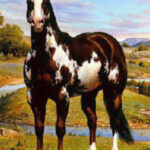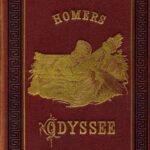My little boy is nine years old and weighs all of sixty pounds. His 9-year-old quarter horse mare is 1,000 pounds of sinew and muscle and big mare spirit. When I watch him catch his horse in the pasture, putting on her halter and then leading that long-legged horse out through the gate for a good grooming or a ride, I am always impressed at her calm and attentive demeanor as she follows him wherever he leads her. The horse stays off to the right of my son’s shoulder as he leads her from the left, slows down when he slows down, speeds up when he speeds up, turns when he turns, stops dead in her tracks when he does, never pulling or barging ahead.
And I can’t take one ounce of credit for that good horse’s behavior. Someone else put those excellent ground manners on that horse. She’s worth her weight in gold with that willing demeanor.
Teaching your horse to lead quietly is essential. It’s a basis for good ground manners, for more advanced work on the longe line, driving, and under saddle. A horse that bolts or jigs around you on the lead line is not only a big pain, but he’s also dangerous.
I’ve been working with my young Percheron draft horse on leading quietly. At 1,700 pounds, good ground manners on a horse his size is an absolute requirement. And the process to do so is primarily mental. A medium-sized woman, I cannot muscle a horse his or any size for that matter. That’s why horse training and the horse sports are not just a physical but primarily a thinking matter.
Tools
The tools for teaching your horse to lead quietly are simple.
Rope Halter. I began teaching my young Percheron horse to lead in a good rope halter with two knots on the noseband. The rope halter enables the horse to feel what I’m asking him to do. The rope halter is a much more effective means of communication than the flat nylon or leather halter, which is really more of a tool for the finished horse.
Lead Rope. I used a long lead rope. Say 10′ or 12′. I tie a good knot on the end of the lead rope to give me a stopping point should my horse become excited and try to get away from me.
Wand or a Dressage Whip. I carry a wand or a dressage whip with me when teaching the horse to lead. I never strike the horse with the wand or the dressage whip. It’s a tool for enhancing my communication with the horse, that’s all. I spend some time prior to the leading lesson desensitizing my horse to the wand or the dressage whip by rubbing the horse all over his body, lightly and gently, with the tool until he is relaxed.
Round Pen, arena, or fenced-in area. For safety reasons, mine and my very large horse’s, I like to work in an enclosed area. If you don’t have a round pen or an arena, work with your horse in a corner of your fenced pasture.
Gloves. Have you ever had a lead rope pulled through your bare hands by a bolting horse? It’s seriously bad news. I really don’t want to be on the barehanded end of 1,700 pounds bolting off from me. I always wear a pair of soft leather gloves when working in-hand with a green horse. A pair of good gloves will give me a little more security and confidence during the training process with my draft horse.
Sturdy boots. I wear sturdy leather boots when working with my horses. They protect your feet from getting stepped on, and I can move more quickly than in, say, clogs or flip-flops certainly!
The Process
Note that the title of this article is “How to Teach Your Horse to Lead Quietly,” not “How to Teach Your Horse to Lead.” Assuming that your horse already understands that you want him to move forward alongside of you in between you and the round pen, arena, or pasture fence, I’m going to discuss how to get him to do so quietly, with an attentive and respectful demeanor and attitude.
As you read the following, think about how I am making it the most comfortable for the horse to do what I am asking him to do. And I am making it uncomfortable for the horse to do something otherwise. Be sure to offer abundant praise when your horse does what you ask him to do.
- I step forward, and indicate with my body leaning forward and by the energy of my step that I want the horse to come with me. I invite the horse to come forward with me.
- As I lead the horse around the arena, he may be tempted to crowd into me, drifting towards the inside of the circle. When that happens, I will allow the horse to meet the butt end of my dressage whip and let him give himself a good poke in the neck, shoulder, or ribs. The horse will get the impression that I’m all knees and elbows whenever he drifts into me. Maintain consistency with this, and soon the horse will learn that it’s easier and more comfortable for him to stay a good arm’s length away when you are leading him.
- As I lead the horse forward, he may try to rush ahead of me. I will give him several good quick corrections with the lead rope until he stops and is standing next to me. I’ll do this without any emotion and without any anger. My approach will be very matter of fact. And then I’ll move forward again and invite the horse to come with me. As long as the horse stays where I want him to be as I’m leading him, I will leave him alone. If he rushes forward, I’ll repeat the corrections. He may circle around me and dance a bit during the correction process. Keep correcting until he stands quietly and then release and reward him by telling the horse he’s a “good boy.” Then begin the leading forward process again. By consistently correcting the horse in this manner, he’ll soon learn that the most comfortable place for him to be is quietly at your shoulder following your every step.
- If the horse doesn’t stop when you stop, let him run into the end of your lead rope where you’re holding it. Don’t pull on the horse. And don’t get angry. This is no place for emotion. You don’t want to turn this into a tug of war, because you’ll simply teach the horse to lean into pressure. Give quick corrections to the horse with short tugs of the lead line and say, “Whoa” firmly. Release the correction as soon as his feet stop moving and he stands quietly. Then repeat the lesson.
Time and consistency are keys to learning
The process above may take a few practice sessions before the horse really understands that you expect him to lead quietly each and every time you pick up the lead rope. Keep your horse engaged and interested as he improves by doing serpentines, turns, small circles. You can practice speeding up and slowing down at a walk until your horse pays such close attention to you that he will match your speed. Make sure to practice on both the left and right side of your horse so that he doesn’t become one-sided. After you’ve mastered the walk, try this work in hand at a trot. Once he’s leading consistently well, take him out of the arena. I take my young Percheron horse for long walks through my rural area. My non-horsy neighbors sometimes cast a perplexed look in our direction, wondering why I’m walking and not riding my big draft horse. They don’t know I’m engaged in a very important aspect of my young horse’s training.
If you are consistent with this every single time you handle your horse, insisting on the horse being where you want him to be when you are leading him, and applying quick corrections when the horse is not, while being sure to release immediately when you get the behavior you’re asking for, pretty soon your horse will be floating alongside of you like my nine-year-old son’s 1,000-pound quarter horse mare!





